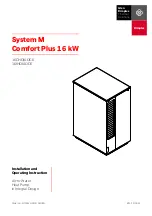
Safety 1
0020250180_00 geoTHERM Installation and maintenance instructions
5
▶
Do not use the products' free terminals as
supporting terminals for other wiring.
▶
At lengths of over 10 m, 230 V connection
cables must be laid separately from sensor
or bus lines.
1.2.6 Preventing the risk of injury from
corrosive brine fluid
The brine fluid ethylene glycol is harmful to
health.
▶
Avoid contact with the skin and eyes.
▶
Always wear gloves and protective
goggles.
▶
Do not inhale or swallow.
▶
Observe the safety data sheet that accom-
panies the brine fluid.
1.2.7 Preventing the risk of injury due
to scalding from hot and cold
components
Particularly in the refrigeration circuit, the
components of the heat pump can reach high
temperatures or extremely low temperatures.
▶
Do not touch any uninsulated pipelines in
any part of the heating installation.
▶
Do not remove any casing sections.
▶
Do not touch the compressor, as it can
become extremely hot during operation.
▶
If the components have reached the envir-
onmental temperature, you can start work.
1.2.8 Risk of injury due to the heavy
weight of the product
▶
Make sure that the product is transported
by at least two people.
1.2.9 Preventing the risk of injury from
freezing as a result of touching
refrigerant
The product is delivered with an operational
filling of R410A refrigerant. This is a chlor-
ine-free refrigerant which does not affect the
Earth's ozone layer. R410A is neither a fire
hazard nor an explosion risk. Escaping refri-
gerant may cause freezing if the exit point is
touched.
▶
If refrigerant escapes, do not touch any
components of the product.
▶
Do not inhale any steam or gases that
escape from the refrigerant circuit as a
result of leaks.
▶
Avoid skin or eye contact with the refriger-
ant.
▶
In the event of skin or eye contact with the
refrigerant, seek medical advice.
1.2.10 Risk of material damage caused by
condensate inside the house
In heating mode, the lines between the heat
pump and the heat source (environment cir-
cuit) are cold, which means that condensate
may form on the lines in the house. In cool-
ing mode, the building circuit lines are cold,
which means that condensate may also form
if the temperature falls below the dew point.
Condensate may lead to material damage,
for example due to corrosion.
▶
Ensure that you do not damage the heat
insulation on the lines.
1.2.11 Material damage due to additives in
the heating water
Unsuitable frost or corrosion protection
agents may damage seals and other com-
ponents of the heating circuit, and may
therefore also cause water leaks.
▶
Only add approved frost and corrosion
protection agents to the heating water.
1.2.12 Damage to the building caused by
missing isolator devices
Missing isolator devices may lead to damage
to the building.
▶
Install the isolator devices that are required
in accordance with the installation stand-
ards.
1.2.13 Frost damage due to an unsuitable
installation site
Frost poses a risk of damage to the product
and the whole heating installation.
Even if rooms, or the whole flat, are not in
use for certain periods, the heating must re-
main in operation.
Frost protection and monitoring devices are
only active while the product is connected
to the power supply. The product must be
connected to the power supply.






































